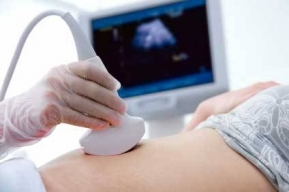But I Want a Baby! Fibroids & Endometriosis’ Effect on Fertility & Pregnancy
Medically Reviewed by J. Michael Davidson, MD
The waiting room air crackled with anxiety. Beth paged through an old Red Book magazine not really paying attention to the articles. Across the room, Rhonda checked her watch to see how long she’d been waiting. Both had the same thought: “Will I be able to get pregnant?”
Beth was diagnosed with fibroids, a tumor-like, non-cancerous growth in her uterus. Rhonda’s last visit confirmed that she had endometriosis, where the material that normally grows as a lining in the uterus, starts growing outside.
Here’s what we know about the connection of fibroids and endometriosis to Beth’s and Rhonda’s ability to get pregnant.
Many women suffering endometriosis do go on to have children. Some sources estimate that 60%-70% of women with endometriosis are fertile. However, fertility problems increase with the severity of the problem and with the woman’s age.
Laparoscopy – surgery using small incisions that leave minimal scars – can remove the growths and scars related to endometriosis, improving chances of becoming pregnant.
These growths can stop a woman from becoming pregnant. Fibroids can create problems for the fertilized egg attaching to the lining of the uterus. Some fibroids grow outside the uterus (submucoscal fibroids), changing the shape of the uterus and making it harder to get pregnant. A surgical treatment, called myomectomy (mi-oh-MECK-toh-mee), can remove the fibroids, while saving the uterus and the ability to get pregnant.
Women who are pregnant, but have undiagnosed fibroids, may deliver prematurely or sadly, may lose the baby through a miscarriage. The fibroids interfere with the baby’s development. Estrogen from the pregnancy may also cause the fibroids to grow faster.
Fibroids in the uterus can cause the baby to be delivered feet first (a breech delivery), which can cause more problems than a “normal” head-first delivery. A C-section may be required if the obstetrician finds that fibroids are blocking the birth canal or are forcing the baby into a dangerous position.
“Both fibroids and endometriosis can make sexual intercourse painful for the woman,” says OB/GYN Dr. Michael Davidson of Advanced Women’s Care. “Some hormonal treatments for both problems can produce a menopause-type state, temporarily treating the problem, but it prevents pregnancy. And hysterectomy – a surgical procedure that removes the uterus and possibly the cervix and fallopian tubes – can be used to treat both problems but will prevent pregnancy. A myomectomy to remove the fibroids can treat the fibroids and allow the patient to retain her fertility. Laparoscopic surgery can remove the endometriosis and also allow the patient to keep her fertility. However, a woman should talk with her Obstetrician about her desire for pregnancy to see if there is a plan that might treat the problem and allow her to be a mother too.”
To find a Gynecologist near you, click here.
Sources include: McLeod Health, National Institutes of Health, US Department of Health & Human Services (Office of Women’s Health), American Society for Reproductive Medicine, endometriosis.org, Medical News Today
-
McLEOD REGIONAL MEDICAL CENTER FLORENCE
843-777-2000 -
McLEOD DARLINGTON
843-777-1100 -
McLEOD DILLON
843-774-4111 -
McLEOD LORIS
843-716-7000 -
McLEOD SEACOAST
843-390-8100 -
McLEOD CHERAW
843-537-7881 -
McLEOD CLARENDON
803-433-3000



-
McLEOD REGIONAL MEDICAL CENTER FLORENCE
843-777-2000 -
McLEOD DARLINGTON
843-777-1100 -
McLEOD DILLON
843-774-4111 -
McLEOD LORIS
843-716-7000 -
McLEOD SEACOAST
843-390-8100 -
McLEOD CHERAW
843-537-7881 -
McLEOD CLARENDON
803-433-3000
 Find a Doctor
Find a Doctor  Locations
Locations  Services
Services 